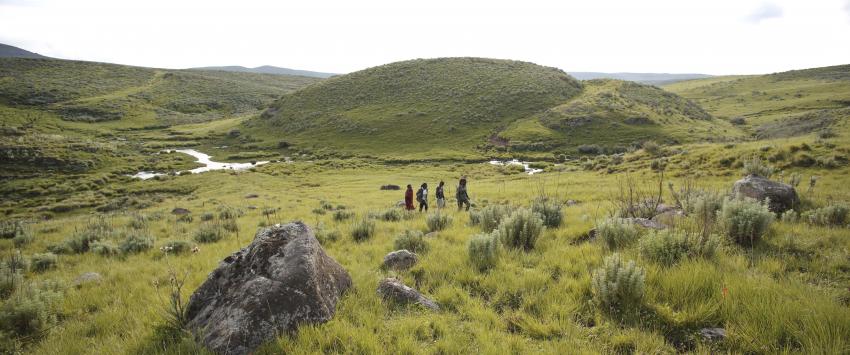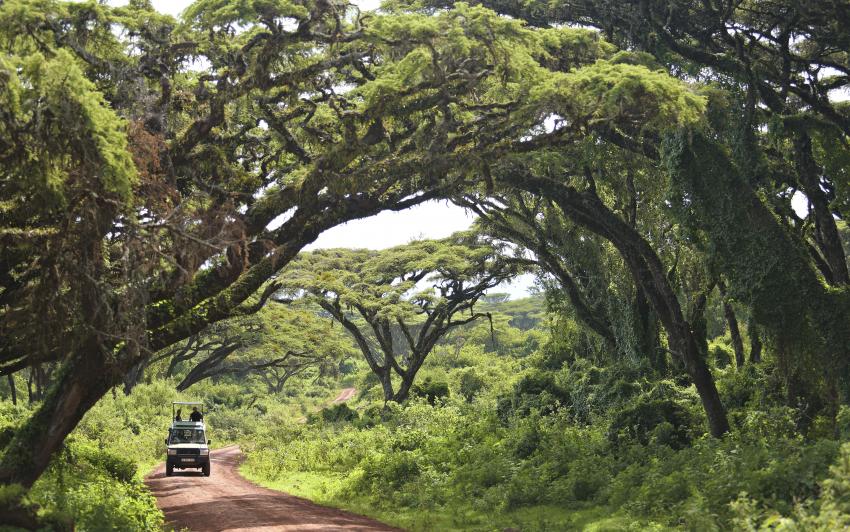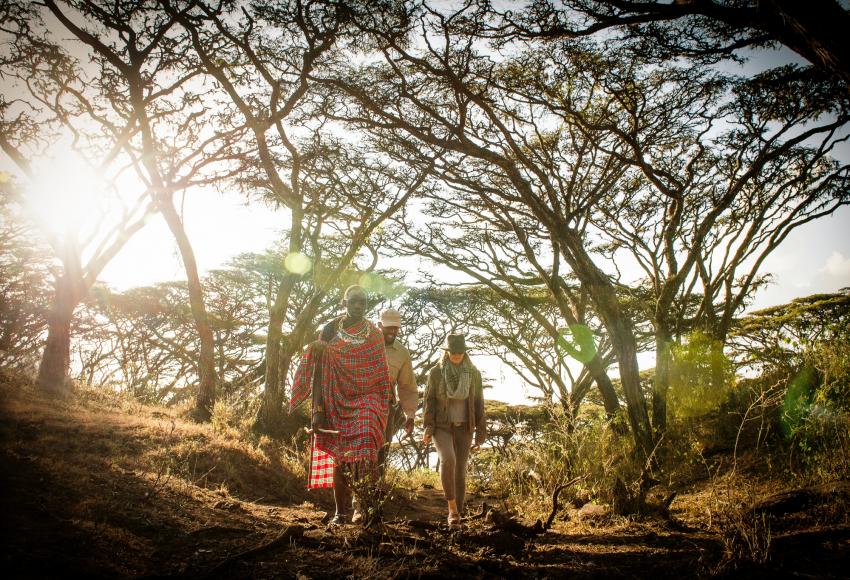Encompassing the spectacular Ngorongoro Crater, which is the largest caldera in the world, the Ngorongoro Conservation Area is a UNESCO World Heritage-listed landscape in the Crater Highlands of Tanzania. It’s home to a staggering diversity of wildlife, as well as the “Cradle of Mankind” at the Olduvai Gorge where one of the earliest known specimens of the human genus was discovered.
The Ngorongoro Conservation Area is one of the world’s first “multi-use areas” where wildlife coexists with semi-nomadic Masai pastoralists who practice traditional livestock grazing. It’s a spectacular destination to visit, with a wide variety of accommodation options ranging from wild camps to luxury lodges, while being within close proximity to the Serengeti National Park, Tarangire National Park and Lake Manyara National Park along what’s been dubbed the “Northern Circuit”
What animals can you see in the Ngorongoro Conservation Area?
The Ngorongoro Conservation Area is a wildlife hotspot, with the crater alone home to around 25,000 large animals, including the “Big 5” (black rhinoceros, elephants, lions, leopards and Cape buffalo). Because of the natural boundaries created by the crater, the lion population is one of the densest in Africa but also relatively inbred, as few migrating males enter the gene pool.

But there are also immense numbers of blue wildebeest, Grant's zebra and elands, as well as Thomson’s and Grant’s gazelles. If you’re visiting during the wet season, you can expect to see far fewer wildebeest and zebra than in the dry. But in exchange, the buffalo and eland populations increase as these species migrate into the crater’s natural enclosure with the coming of the rains.
While cheetahs and East African wild dogs are present in the Ngorongoro Conservation Area, they are rarely seen. Spotted hyenas and servals are sometimes sighted, however, with the help of an experienced guide’s keen eye. The crater is also renowned for its flamingo population, particularly around Lake Magadi in the southwest where thousands of lesser flamingos can be seen feeding in the shallows.

Aside from the crater, the Ngorongoro Conservation Area encompasses the wildlife-rich Ndutu Lake area in the west of the reserve, which is renowned for its sightings of cheetah, hartebeest, spotted hyenas and lions. If you want to see the annual wildebeest migration passing through, plan your visit around December as the herds are moving south or June when they’re heading north towards the Masai Mara.
Both the Ngorongoro Highlands and the crater offer excellent bird watching, with more than 500 different species recorded. In addition to large birds such as ostrich and crowned cranes, you can also spot white-eyed slaty flycatcher, Livingstone turaco and a range of specialised grassland birds that are resident in the crater. If you visit between November and April, you’ll also witness a number of migratory species who make the long journey from Europe and Asia.
How to get to Ngorongoro Conservation Area
The Kilimanjaro International Airport is the major gateway for visitors heading to the Ngorongoro Conservation Area. Most safaris start from Arusha, which is just under 50 kilometres drive from the Kilimanjaro International Airport. Alternatively, you can fly into the Julius Nyerere International Airport in Dar es Salaam and take a domestic flight direct to the Arusha Airport.
From Arusha, it’s about three hours’ drive to the Ngorongoro Conservation Area, travelling through spectacular scenery and with the opportunity to spot wildlife along the way. After visiting Ngorongoro, many visitors add on a trip to the Serengeti, with the popular Seronera area around three hours away. One option is to take a scheduled flight to the Serengeti and travel back to Arusha via the Ngorongoro Conservation Area by safari vehicle or vice versa.
Best time to visit Ngorongoro Conservation Area
The Ngorongoro Conservation Area is an exceptional wildlife viewing destination throughout the year. But the dry season from June to October is generally considered the best time to visit, with shorter grasses making spotting animals easier. These months are characterised by sunny skies and little rainfall, with fewer mosquitoes in the evenings. Lodge and camp rates around the crater tend to be at their highest and you should keep in mind that the mornings and nights can get very cold.

From November to May, the landscapes transform a lush green during the wet season, with short, afternoon showers and storms that rarely interfere with travel plans. This is an ideal time to visit for bird watching, with migratory species flocking to the wetlands. Some lodges and camps may reduce their rates and there are far fewer people visiting during this period.
Where to stay in the Ngorongoro Conservation Area

Ngorongoro Crater
It comes as a surprise to some visitors that no accommodation or camping facilities exist within the Ngorongoro Crater itself. However, there is a wide choice of options to suit all styles along the crater rim, ranging from upmarket luxury lodges to budget-friendly campsites. Many offer exceptional views of the crater floor and this is one of the most sought-after areas for people to stay who are first-time visitors to the reserve.

Ndutu
The Ndutu area lies along the border of the Ngorongoro Conservation Area where it meets the Serengeti National Park and is characterised by woodlands and two soda-rich lakes surrounded by endless grassy plains. During the dry season, Ndutu is visited by nomadic pastoralists who come to graze their livestock at what is the only permanent source of water in the region. When the rains arrived, they are replaced by hundreds of thousands of wildebeest, zebra and antelope on their annual migration who fill the grasslands during the calving season.

There are a handful of permanent lodges and tented camps scattered around Ndutu Lake where you can stay and experience the annual migration, away from the crowds of Ngorongoro Crater. There is also a tented lodge near the shores of Lake Masek, which lies just to the east, where guests are invited to stay.
Olduvai Gorge
To the east of Ndutu is the Olduvai Gorge, a steep-sided ravine in the Great Rift Valley that extends for around 50 kilometres in length. It lies in the rain shadow of the Ngorongoro Highlands and is one of the driest parts of the Ngorongoro Conservation Area.
It’s believed that millions of years ago the gorge was filled by a vast lake and it wasn’t until the 1950s that excavation work was first conducted by Mary and Louis Leakey. Olduvai Gorge has since been identified as one of the most important prehistoric sites in the world in developing our understanding of early human evolution, with a fascinating museum for visitors to discover today.

If you’re particularly interested in visiting Olduvai, there’s a luxury camp on the edge of the gorge where guests are welcome to stay. It’s only around 30 minutes’ drive from the Ngorongoro Crater and surrounded by villages of Masai tribes people who have remained on their ancestral lands and maintain their traditional way of life.
Want to plan a safari in the Ngorongoro Conservation Area? Check out our range of permanent luxury lodges and mobile tented camps to experience this natural wonder.

 1-321-766-6821
1-321-766-6821 











